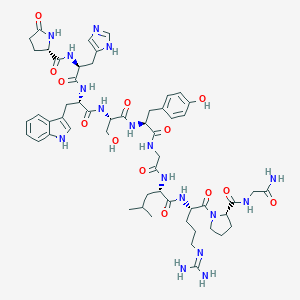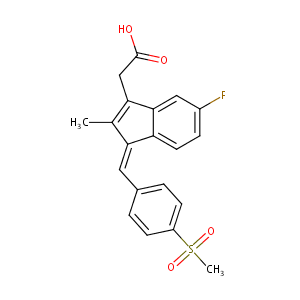| 1 |
ClinicalTrials.gov (NCT00283803) Exisulind and Intermittent Androgen Suppression (ADT) in Biochemical Relapsed Prostate Cancer
|
| 2 |
Gonadorelin FDA Label
|
| 3 |
URL: http://www.guidetopharmacology.org Nucleic Acids Res. 2015 Oct 12. pii: gkv1037. The IUPHAR/BPS Guide to PHARMACOLOGY in 2016: towards curated quantitative interactions between 1300 protein targets and 6000 ligands. (Ligand id: 4391).
|
| 4 |
ClinicalTrials.gov (NCT00085826) A Phase III Study of the Efficacy of Taxotere/Aptosyn Versus Taxotere/Placebo in Non-Small Cell Lung Cancer Patients. U.S. National Institutes of Health.
|
| 5 |
Use of cognitive behavior therapy for functional hypothalamic amenorrhea. Ann N Y Acad Sci. 2006 Dec;1092:114-29.
|
| 6 |
Ion-exchange chromatography: basic principles and application to the partial purification of soluble mammalian prolyl oligopeptidase. Methods Mol Biol. 2011;681:215-28.
|
| 7 |
Sleep deprivation changes thimet oligopeptidase (THOP1) expression and activity in rat brain. Heliyon. 2019 Nov 26;5(11):e02896.
|
| 8 |
Cell-specific activity of neprilysin 2 isoforms and enzymic specificity compared with neprilysin. Biochem J. 2002 May 1;363(Pt 3):697-705.
|
| 9 |
Activation of protein kinase G up-regulates expression of 15-lipoxygenase-1 in human colon cancer cells. Cancer Res. 2005 Sep 15;65(18):8442-7.
|
| 10 |
Sulindac and its metabolites induce carcinogen metabolizing enzymes in human colon cancer cells. Int J Cancer. 2008 Mar 1;122(5):990-8.
|
| 11 |
Nonsteroidal anti-inflammatory drugs induce colorectal cancer cell apoptosis by suppressing 14-3-3epsilon. Cancer Res. 2007 Apr 1;67(7):3185-91. doi: 10.1158/0008-5472.CAN-06-3431.
|
| 12 |
Glucuronidation of nonsteroidal anti-inflammatory drugs: identifying the enzymes responsible in human liver microsomes. Drug Metab Dispos. 2005 Jul;33(7):1027-35.
|
| 13 |
Exisulind induction of apoptosis involves guanosine 3',5'-cyclic monophosphate phosphodiesterase inhibition, protein kinase G activation, and attenuated beta-catenin. Cancer Res. 2000 Jul 1;60(13):3338-42.
|
| 14 |
Exisulind induction of apoptosis involves guanosine 3',5'-cyclic monophosphate phosphodiesterase inhibition, protein kinase G activation, and attenuated beta-catenin. Cancer Res. 2000 Jul 1;60(13):3338-42.
|
| 15 |
Cyclic GMP mediates apoptosis induced by sulindac derivatives via activation of c-Jun NH2-terminal kinase 1. Clin Cancer Res. 2000 Oct;6(10):4136-41.
|
| 16 |
Cyclic GMP-dependent protein kinase activation and induction by exisulind and CP461 in colon tumor cells. J Pharmacol Exp Ther. 2001 Nov;299(2):583-92.
|
| 17 |
GATA-6 transcriptional regulation of 15-lipoxygenase-1 during NSAID-induced apoptosis in colorectal cancer cells. Cancer Res. 2002 Feb 15;62(4):1178-83.
|
| 18 |
PPARgamma-mediated antineoplastic effect of NSAID sulindac on human oral squamous carcinoma cells. Int J Cancer. 2002 Apr 20;98(6):817-23.
|
| 19 |
Cyclooxygenase-independent induction of apoptosis by sulindac sulfone is mediated by polyamines in colon cancer. J Biol Chem. 2003 Nov 28;278(48):47762-75.
|
| 20 |
Activation of protein kinase G Increases the expression of p21CIP1, p27KIP1, and histidine triad protein 1 through Sp1. Cancer Res. 2008 Jul 1;68(13):5355-62.
|
| 21 |
Sulindac sulfide-induced apoptosis involves death receptor 5 and the caspase 8-dependent pathway in human colon and prostate cancer cells. Cancer Res. 2001 Sep 15;61(18):6918-24.
|
| 22 |
Sulindac metabolites induce proteosomal and lysosomal degradation of the epidermal growth factor receptor. Cancer Prev Res (Phila). 2010 Apr;3(4):560-72. doi: 10.1158/1940-6207.CAPR-09-0159. Epub 2010 Mar 23.
|
| 23 |
Sulindac sulfide and exisulind inhibit expression of the estrogen and progesterone receptors in human breast cancer cells. Clin Cancer Res. 2006 Jun 1;12(11 Pt 1):3478-84. doi: 10.1158/1078-0432.CCR-05-2051.
|
| 24 |
Safety and efficacy of exisulind for treatment of recurrent prostate cancer after radical prostatectomy. J Urol. 2001 Sep;166(3):882-6.
|
| 25 |
A comparison of the effectiveness of selected non-steroidal anti-inflammatory drugs and their derivatives against cancer cells in vitro. Cancer Chemother Pharmacol. 2008 Feb;61(2):203-14. doi: 10.1007/s00280-007-0462-3. Epub 2007 Apr 20.
|
| 26 |
Nobiletin, a citrus flavonoid, down-regulates matrix metalloproteinase-7 (matrilysin) expression in HT-29 human colorectal cancer cells. Biosci Biotechnol Biochem. 2005 Feb;69(2):307-14. doi: 10.1271/bbb.69.307.
|
| 27 |
15-Hydroxyprostaglandin dehydrogenase (15-PGDH) is up-regulated by flurbiprofen and other non-steroidal anti-inflammatory drugs in human colon cancer HT29 cells. Arch Biochem Biophys. 2009 Jul 15;487(2):139-45. doi: 10.1016/j.abb.2009.05.017. Epub 2009 Jun 6.
|
| 28 |
Pro-apoptotic actions of exisulind and CP461 in SW480 colon tumor cells involve beta-catenin and cyclin D1 down-regulation. Biochem Pharmacol. 2002 Nov 1;64(9):1325-36. doi: 10.1016/s0006-2952(02)01345-x.
|
| 29 |
Inhibition of extracellular-signal regulated kinases 1/2 is required for apoptosis of human colon cancer cells in vitro by sulindac metabolites. Cancer Res. 2004 Nov 15;64(22):8148-51. doi: 10.1158/0008-5472.CAN-04-1517.
|
| 30 |
Effects of acidic non-steroidal anti-inflammatory drugs on human cytochrome P450 4A11 activity: Roles of carboxylic acid and a sulfur atom in potent inhibition by sulindac sulfide. Chem Biol Interact. 2023 Sep 1;382:110644. doi: 10.1016/j.cbi.2023.110644. Epub 2023 Jul 25.
|
| 31 |
The proapoptotic effects of sulindac, sulindac sulfone and indomethacin are mediated by nucleolar translocation of the RelA(p65) subunit of NF-kappaB. Oncogene. 2008 Apr 17;27(18):2648-55. doi: 10.1038/sj.onc.1210891. Epub 2007 Dec 3.
|
| 32 |
Sulindac enhances adenoviral vector expressing mda-7/IL-24-mediated apoptosis in human lung cancer. Mol Cancer Ther. 2005 Feb;4(2):291-304.
|
|
|
|
|
|
|


